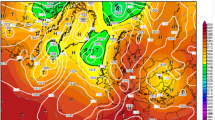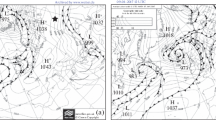Abstract
The Town Energy Budget (TEB) model, a detailed urban parameterisation using a generalised canyon geometry, coupled with the Regional Atmospheric Modelling System (RAMS) is used to simulate the wintertime local circulation in the megacity environment of the metropolitan area of Sao Paulo (MASP) in Brazil. Model simulations are performed using actual topography and land-use fields. Comparison with a simple urban parameterisation based on the LEAF-2 scheme is also shown. Validation is based on comparison between model simulations and observations. Sensitivity tests with TEB reveal an important interaction between the sea breeze and the MASP heat island circulation. Even though topography is known to play an important role in the MASP region’s weather, in these tests the simulations were performed without topography in order to unambiguously identify the interaction between the two local circulations. The urban heat island (UHI) forms a strong convergence zone in the centre of the city and thereby accelerates the sea-breeze front toward the centre of the city. The presence of the urban region increases the sea-breeze front propagation mean speed by about 0.32 m s−1 when compared with the situation of no city. After its arrival in the urban region, the sea-breeze front stalls over the centre of the city for about 2 h. Subsequently, the sea breeze progresses beyond the city when the heat island dissipates. Thereafter, the sea breeze propagates beyond the urban area at a decelerated rate compared to a simulation without an UHI.
Similar content being viewed by others
References
Ado HY (1992) Numerical study of the daytime urban effect and its interaction with the sea-breeze. J Appl Meteorol 31:1146–1164
Baik JJ, Kim YH, Chun HY (2001) Dry and moist convection forced by an urban heat island. J Appl Meteorol 40(8):1462–1475
Baik JJ, Kim JJ (2002) On the escape of pollutants from urban street canyons. Atmos Environ 36:527–536
Balling RC, Skindlov JA, Philips DH (1990) The impact of increasing summer mean temperatures on extreme maximum and minimum temperatures in Phoenix, Arizona. J Climate 3:1491–1494
Bornstein RD (1975) The two-dimensional URBMET urban boundary layer model. J Appl Meteorol 14:1459–1477
Changnon SA, Huff FA, Semonin RG (1971) METROMEX: an investigation of inadvertent weather modification. Bull Amer Meteorol Soc 52:958–968
Cotton WR et al (2003) RAMS 2001: current status and future directions. Meteorol Atmos Phys 82:5–29
Dixon PG, Mote T (2003) Patterns and causes of Atlanta’s urban heat island – initiated precipitation. J Appl Meteorol 2:1273–1284
Gedzelman SD, Austin S, Cermak R, Stefano N, Partridge S, Quesenberry S, Robinson DA (2003) Mesoscale aspects of the urban heat island around New York City. Theor Appl Climatol 75:29–42
Grimmond CSB, Oke TR (1999) Aerodynamic properties of urban areas derived from analysis of surface form. J Appl Meteorol 38:1262–1292
Hill GE (1974) Factors controlling the size and spacing of cumulus clouds as revealed by numerical experiments. J Atmos Sci 31:646–673
Khan SM, Simpson RW (2001) Effect of a heat island on the meteorology of complex urban airshed. Boundary-Layer Meteorol 100:487–506
Kimura R (1976) Effects of general flows on a heat island convection, part 1 – linear theory for the uniform flow. J Meteorol Soc Japan 54:308 –320
Kim YH, Baik JJ (2002) Maximum urban heat island intensity in Seoul. J Appl Meteorol 41:651–659
Kim JJ, Baik JJ (2004) A numerical study of the effects of ambient wind direction on flow and dispersion in urban street canyons using the RNG k–e turbulence model. Atmos Environ 38:3039–3048
Klemp JB, Wilhelmson RB (1978) The simulation of three-dimensional convective storm dynamics. J Atmos Sci 35:1070–1096
Lilly DK (1962) On the numerical simulation of buoyant convection. Tellus, XIV 2:148–172
Mahrer Y, Pielke RA (1977) A numerical study of the airflow over irregular terrain. Beit Phys der Atmos 50:98–113
Masson V (2000) A physically-based scheme for the urban energy budget in atmospheric models. Boundary-Layer Meteorol 94:357–397
Morris CJG, Simmonds I, Plummer N (2001) Quantification of the influences of wind and cloud on the nocturnal urban heat island of a large city. J Appl Meteorol 40:169–182
Ohashi Y, Kida H (2002) Local circulations developed in the vicinity of both coastal and inland urban areas: a numerical study with a mesoscale atmospheric model. J Appl Meteorol 41:30–45
Oke TR (1978) Boundary layer climates, 2nd edn. Rutledge, London and New York, 435 pp
Pielke RA et al (1992) A comprehensive meteorological modeling system – RAMS. Meteorol Atmos Phys 49:69–91
Pielke RA Sr (2002) Mesoscale meteorological modeling, 2nd edn. Academic Press, San Diego, 676 pp
Rozoff CM, Cotton WR, Adegoke JO (2003) Simulation of St. Louis, Missouri, land use impacts on thunderstorms. J Appl Meteorol 42(6):716–738
Sailor DJ (1995) Simulated urban climate response to modifications in surface Albedo and vegetative cover. J Appl Meteorol 34:1694–1704
Smagorinsky J (1963) General circulation experiments with the primitive equations: 1. the basic experiment. Mon Wea Rev 91:99–164
Stull RB (1988) An introduction to boundary layer meteorology. Kluwer Academic Publishers, The Netherlands, 670 pp
Tarifa JR, Azevedo TR 2001, Os climas na cidade de São Paulo: teoria e prática. GEOUSP – Coleção Novos Caminhos, 4, São Paulo, 199 pp
Walko RL et al (2000) Coupled atmosphere-biophysics-hydrology models for environmental modeling. J Appl Meteorol 39:931–944
Wieringa J (1993) Representative roughness parameters for homogeneous terrain. Boundary-Layer Meteorol 63:323–363
Wilks DS (1995) Statistical methods in the atmospheric sciences. Academic Press, San Diego, 467 pp
Yoshikado H (1994) Interaction of the sea-breeze with urban heat islands of different sizes and locations. J Meteorol Soc Japan 72:139–143
Yoshikado H, Tsuchida M (1996) High levels of winter air pollution under the influence of the urban heat island along the shore of Tokyo Bay. J Appl Meteorol 35:1804–1814
Author information
Authors and Affiliations
Corresponding author
Rights and permissions
About this article
Cite this article
Freitas, E.D., Rozoff, C.M., Cotton, W.R. et al. Interactions of an urban heat island and sea-breeze circulations during winter over the metropolitan area of São Paulo, Brazil. Boundary-Layer Meteorol 122, 43–65 (2007). https://doi.org/10.1007/s10546-006-9091-3
Received:
Accepted:
Published:
Issue Date:
DOI: https://doi.org/10.1007/s10546-006-9091-3




